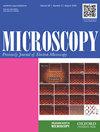像素化探测器离轴电子全息术的相位检测极限:增益变化、几何畸变和参考全息图校正失败
IF 1.8
4区 工程技术
引用次数: 1
摘要
我们研究了在像素化探测器(如电荷耦合器件(CCD)和直接探测器件(DDD))上记录离轴电子全息图对测量振幅和相位的影响。将针对具有增益变化和像素位移的完美均匀干涉条纹照射不完美检测器的情况来发展理论。我们将证明,这两种类型的缺陷在相位图像中都会产生系统噪声,该噪声取决于全息条纹相对于检测器的位置。因此,如果两个全息图的初始相位不完全一致,那么从物体全息图中减去参考全息图将不会去除相位噪声。另一个发现是π移位全息图受增益变化的影响要小得多,但在几何失真方面没有改善。将对由此产生的相位误差进行估计,并进行模拟,以证实理论发展。本文章由计算机程序翻译,如有差异,请以英文原文为准。
Phase detection limits in off-axis electron holography from pixelated detectors: gain variations, geometric distortion and failure of reference-hologram correction
We investigate the effect that recording off-axis electron holograms on pixelated detectors, such as charge-coupled devices (CCD) and direct-detection devices (DDD), can have on measured amplitudes and phases. Theory will be developed for the case of perfectly uniform interference fringes illuminating an imperfect detector with gain variations and pixel displacements. We will show that both these types of defect produce a systematic noise in the phase images that depends on the position of the holographic fringes with respect to the detector. Subtracting a reference hologram from the object hologram will therefore not remove the phase noise if the initial phases of the two holograms do not coincide exactly. Another finding is that pi-shifted holograms are much less affected by gain variations but show no improvement concerning geometric distortions. The resulting phase errors will be estimated and simulations presented that confirm the theoretical developments.
求助全文
通过发布文献求助,成功后即可免费获取论文全文。
去求助
来源期刊

Microscopy
工程技术-显微镜技术
自引率
11.10%
发文量
0
审稿时长
>12 weeks
期刊介绍:
Microscopy, previously Journal of Electron Microscopy, promotes research combined with any type of microscopy techniques, applied in life and material sciences. Microscopy is the official journal of the Japanese Society of Microscopy.
 求助内容:
求助内容: 应助结果提醒方式:
应助结果提醒方式:


